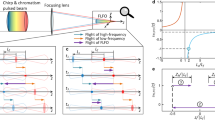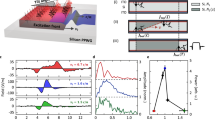Abstract
Einstein's theory of special relativity and the principle of causality1,2,3,4 imply that the speed of any moving object cannot exceed that of light in a vacuum (c). Nevertheless, there exist various proposals5,6,7,8,9,10,11,12,13,14,15,16,17,18 for observing faster-than- c propagation of light pulses, using anomalous dispersion near an absorption line4,6,7,8, nonlinear9 and linear gain lines10,11,12,13,14,15,16,17,18, or tunnelling barriers19. However, in all previous experimental demonstrations, the light pulses experienced either very large absorption7 or severe reshaping9,19, resulting in controversies over the interpretation. Here we use gain-assisted linear anomalous dispersion to demonstrate superluminal light propagation in atomic caesium gas. The group velocity of a laser pulse in this region exceeds c and can even become negative16,17, while the shape of the pulse is preserved. We measure a group-velocity index of ng = -310(±5); in practice, this means that a light pulse propagating through the atomic vapour cell appears at the exit side so much earlier than if it had propagated the same distance in a vacuum that the peak of the pulse appears to leave the cell before entering it. The observed superluminal light pulse propagation is not at odds with causality, being a direct consequence of classical interference between its different frequency components in an anomalous dispersion region.
This is a preview of subscription content, access via your institution
Access options
Subscribe to this journal
Receive 51 print issues and online access
$199.00 per year
only $3.90 per issue
Buy this article
- Purchase on Springer Link
- Instant access to full article PDF
Prices may be subject to local taxes which are calculated during checkout




Similar content being viewed by others
References
Einstein, A., Lorentz, H. A., Minkowski, H. & Weyl, H. The Principle of Relativity, Collected Papers (Dover, New York, 1952).
Born, M. & Wolf, E. Principle of Optics 7th edn (Cambridge Univ. Press, Cambridge, 1997).
Landau, L. D. & Lifshitz, E. M. Electrodynamics of Continuous Media (Pergamon, Oxford, 1960).
Brillouin, L. Wave Propagation and Group Velocity (Academic, New York, 1960).
Chiao, R. Y. in Amazing Light, a Volume Dedicated to C. H. Townes on His Eightieth Birthday (ed. Chiao, R. Y.) 91–108 (Springer, New York, 1996).
Garrett, C. G. B. & McCumber, D. E. Propagation of a gaussian light pulse through an anomalous dispersion medium. Phys. Rev. A 1, 305–313 (1970).
Chu, S. & Wong, S. Linear pulse propagation in an absorbing medium. Phys. Rev. Lett. 48, 738– 741 (1982).
Akulshin, A. M., Barreiro, S. & Lezama, A. Steep anomalous dispersion in coherently prepared Rb vapor. Phys. Rev. Lett. 83, 4277– 4280 (1999).
Basov, N. G., Ambartsumyan, R. V., Zuev, V. S., Kryukov, P. G. & Letokhov, V. S. Nonlinear amplification of light pulses. Sov. Phys. JETP 23, 16– 22 (1966).
Casperson, L. & Yariv, A. Pulse propagation in a high-gain medium. Phys. Rev. Lett. 26, 293– 295 (1971).
Icsevgi, A. & Lamb, W. E. Propagation of light pulses in a laser amplifier. Phys. Rev. 185, 517– 545 (1969).
Picholle, E., Montes, C., Leycuras, C., Legrand, O. & Botineau, J. Observation of dissipative superluminous solitons in a Brillouin fiber ring laser. Phys. Rev. Lett. 66, 1454–1457 (1991).
Fisher, D. L. & Tajima, T. Superluminous laser pulse in an active medium. Phys. Rev. Lett. 71, 4338– 4341 (1993).
Chiao, R. Y. Superluminal (but causal) propagation of wave packets in transparent media with inverted atomic populations. Phys. Rev. A 48, R34–R37 (1993).
Bolda, E. L., Chiao, R. Y. & Garrison, J. C. Two theorems for the group velocity in dispersive media. Phys. Rev. A 48, 3890– 3894 (1993).
Steinberg, A. M. & Chiao, R. Y. Dispersionless, highly superluminal propagation in a medium with a gain doublet. Phys. Rev. A 49, 2071–2075 (1994).
Mitchell, M. W. & Chiao, R. Y. Causality and negative group delays in a simple bandpass amplifier. Am. J. Phys. 66, 14–19 ( 1998).
Bolda, E., Garrison, J. C. & Chiao, R. Y. Optical pulse propagation at negative group velocities due to a nearby gain line. Phys. Rev. A 49, 2938–2947 (1994).
Steinberg, A. M., Kwiat, P. G. & Chiao, R. Y. Measurement of the single-photon tunneling time. Phys. Rev. Lett. 71, 708– 711 (1993).
Harris, S. E. Electromagnetically induced transparency. Phys. Today 50, 36–42 (1997).
Scully, M. O. & Zubairy, M. S. Quantum Optics (Cambridge Univ. Press, 1997).
Xiao, M., Li, Y.-Q., Jin, S.-Z. & Gea-Banacloche, J. Measurement of dispersion properties of electromagnetically induced transparency in rubidium atoms. Phys. Rev. Lett. 74, 666– 669 (1995).
Hau, L. V., Harris, S. E., Dutton, Z. & Behroozi, C. H. Light speed reduction to 17 meters per second in an untracold atomic gas. Nature 397, 594–598 (1999).
Kash, M. M. et al. Ultraslow group velocity and enhanced nonlinear optical effects in a coherently driven hot atomic gas. Phys. Rev. Lett. 82, 5229–5232 (1999).
Budker, D., Kimball, D. F., Rochester, S. M. & Yashchuk, V. V. Nonlinear magneto-optics and reduced group velocity of light in atomic vapor with slow ground state relaxation. Phys. Rev. Lett. 83, 1767–1770 (1999).
Acknowledgements
We thank R. A. Linke for several stimulating discussions. We thank D. K. Walter, W. Happer, J. A. Giordmaine, D. J. Chadi, S. A. Solin, R. Y. Chiao, S. E. Harris and E. S. Polzik for helpful discussions. We thank E. B. Alexandrov and N. P. Bigelow for the use of the paraffin-coated caesium cells.
Author information
Authors and Affiliations
Corresponding author
Rights and permissions
About this article
Cite this article
Wang, L., Kuzmich, A. & Dogariu, A. Gain-assisted superluminal light propagation. Nature 406, 277–279 (2000). https://doi.org/10.1038/35018520
Received:
Accepted:
Issue Date:
DOI: https://doi.org/10.1038/35018520
This article is cited by
-
Ab initio prediction of the structural, optoelectronic and thermoelectric properties of double half-Heusler (DHH) ScXRh2Bi2 (X = Nb, Ta) alloys DFT study results
Indian Journal of Physics (2024)
-
Full characterization of superradiant pulses generated from a free-electron laser oscillator
Scientific Reports (2023)
-
Controlling the Goos-Hänchen shift in a double prism structure using three-level Raman gain medium
Scientific Reports (2023)
-
Azimuthal quantum number dependent two dimensional atom microscopy, via atom cavity coupling
Optical and Quantum Electronics (2023)
-
Phase sensitivity by fast light propagation using compton scattering and Kerr non-linearity
Optical and Quantum Electronics (2023)
Comments
By submitting a comment you agree to abide by our Terms and Community Guidelines. If you find something abusive or that does not comply with our terms or guidelines please flag it as inappropriate.



